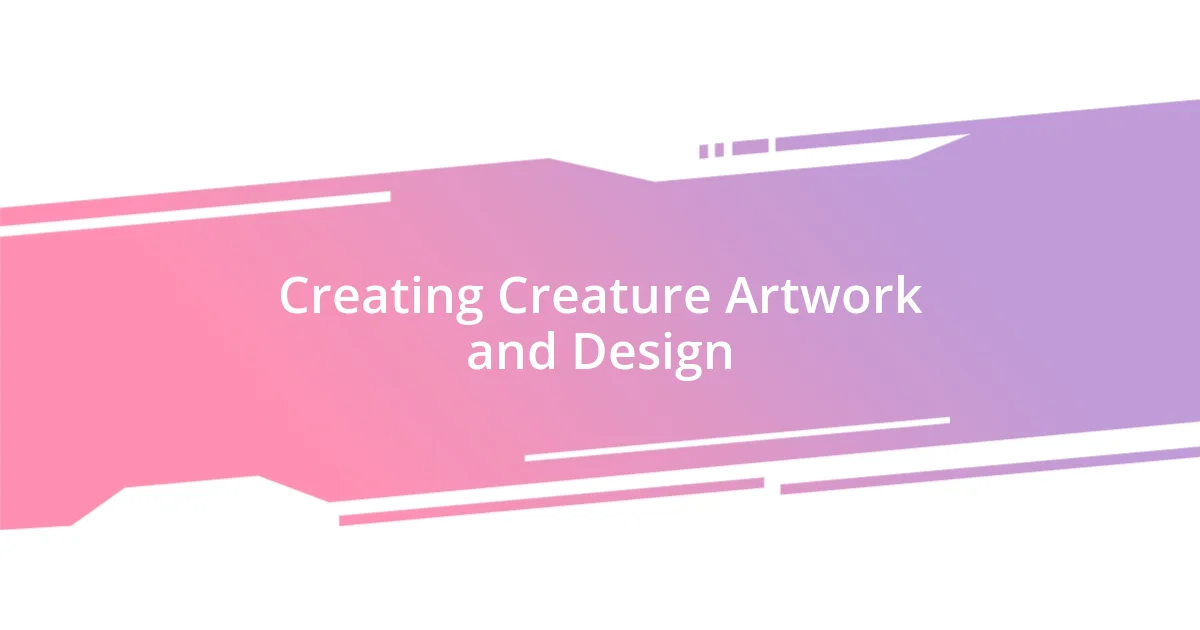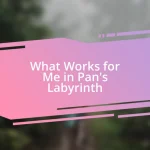Key takeaways:
- Fantasy creatures serve as metaphors reflecting human emotions and experiences, enhancing narrative depth and connection.
- Conceptualizing creature origins involves cultural inspiration, environmental adaptation, and emotional significance to foster engagement in storytelling.
- Integrating creatures into worldbuilding requires consideration of their ecological roles and cultural significance, enriching the overall narrative experience.

Understanding Fantasy Creatures
When I think about fantasy creatures, I often reflect on their role in shaping the narratives that we love. Have you ever noticed how these beings can evoke strong emotions? For me, encountering a dragon in a story always ignites a mix of awe and fear, reminding me of the dilemmas we face in our own lives.
Each fantasy creature serves as a metaphor, often reflecting aspects of humanity. Consider the gentle, misunderstood monster or the fierce protector; they resonate with our struggles and dreams. I remember the first time I invented a creature inspired by my childhood insecurities, and it felt liberating to give those feelings a tangible form.
When it comes to understanding these beings, it’s crucial to delve into their origins and purpose in a story. What drives their motivations? My experience has shown me that creatures born from personal experiences often carry the most weight. They create bridges between the fantastical and the real, inviting readers to explore deeper themes of identity and belonging.

Conceptualizing Creature Origins
Conceptualizing the origins of fantasy creatures is where the magic begins. I often draw inspiration from different cultural myths and folklore, as they contain layers of symbolism that resonate with our collective consciousness. For instance, I once crafted a creature based on the phoenix, representing renewal and resilience, which allowed me to explore themes of rebirth in my stories. This blend of background and personal reflection makes the process feel incredibly rewarding.
Another essential aspect is considering the environment where the creature might exist. I recall brainstorming a creature that thrived in a teeming, bioluminescent jungle. It had adaptations that reflected its ecosystem, like translucent skin and glowing markings to attract mates. This connection between creature and habitat not only fuels creativity but also enriches the storytelling, making the creature feel more alive and believable.
Lastly, I believe that a creature’s origin story should have emotional weight. When I developed a creature that arose from an ancient curse, it echoed my feelings about generational trauma. This connection might not be immediately apparent to all readers, but those who delve into the story’s subtext get to experience a deeper bond with the creature, creating a lasting impact. How do you imagine your creatures coming to life?
| Factor | Explanation |
|---|---|
| Inspiration Sources | Utilizing cultural myths, personal experiences, and emotional insights |
| Environment | Designing habitats that shape the creature’s adaptations and behaviors |
| Emotional Weight | Crafting backstories that connect the creature to relatable human experiences |

Researching Existing Fantasy Species
Researching Existing Fantasy Species
When I dive into the world of existing fantasy species, I find that studying their characteristics and origins offers invaluable insights. Each creature I read about feels like a window into the creativity of its creator. For instance, I was fascinated by how elves are often portrayed—sometimes as ethereal beings, other times as fierce warriors. This variability scores deep into what fantasy creatures can evoke in terms of emotion and concept.
To facilitate my research, I often compile a list of existing fantasy species to understand the core elements that make them resonate. Here’s a snapshot of what I usually focus on:
- Cultural Representation: How does the species embody cultural traits or societal ideals?
- Physical Attributes: What unique physical features set them apart from other creatures?
- Powers and Abilities: What special skills or magical abilities do they possess that influence their role in stories?
- Symbolism: What deeper meanings or themes do these creatures represent?
- Narrative Role: Are they allies, villains, or neutral forces? How does this shape the story?
By examining these facets, I can identify what resonates most with me while discovering how to weave my authentic voice into their fabric. It’s that blend of study and personal reflection that sparks my own imagination and leads to unique creations.
Researching existing fantasy species isn’t just an academic endeavor; it’s a deep, emotional journey. I remember the thrill of discovering the kitsune, a fox spirit from Japanese folklore. Its dual nature—playful yet cunning—spoke to my own experiences with trust and deception in friendships. This personal connection drives me to explore such beings more profoundly, as their stories often echo my own or those around me.
Through this lens of personal experience, I find a richness in each mythical being, which fuels my creativity and helps me craft my own distinct species. Engaging with the established lore while reflecting on my feelings creates a tapestry of inspiration that feeds my imaginative well.

Defining Unique Physical Traits
When defining unique physical traits for my fantasy creatures, I like to start with a few standout features that really capture their essence. For instance, I once imagined a creature with iridescent scales that changed color based on its mood. It not only set this being apart but also made it relatable on a human level, sparking curiosity about how emotions shape our identities. Have you thought about how physical traits can mirror personality? I find that visual cues often help readers feel more connected to a character.
Another unique trait I explored was a creature possessing multiple eyes arranged in a spiral pattern. This design not only gave it an otherworldly appearance but also symbolized its ability to perceive truths hidden from others. This combination of horror and allure fueled my creativity as I envisioned its role as a guardian of secrets. I can’t help but wonder how you might visualize a creature that sees things in a way we humans might struggle to comprehend.
Finally, I believe that the size and shape of a creature can convey powerful messages about its role in the ecosystem. One of my favorite designs was a giant, lumbering beast with long, flowing appendages that resembled leaves. Not only was it visually striking, but it served as a gentle giant, playing a vital part in its habitat by spreading seeds. This made me realize how every physical aspect can reveal a creature’s function and purpose. What unique traits might you incorporate into your own creations to give them depth and meaning?

Crafting Behavioral Characteristics
Crafting behavioral characteristics is a fascinating exercise in empathy. When I design a creature, I often think about its motivations and fears. For instance, I once created a creature that hoarded shiny objects out of a deep-seated fear of loss. It struck me how this motivated behavior could resonate with readers, reflecting our own tendencies to hold on tightly to what we cherish. Have you ever noticed how our fears can drive our actions?
As I fine-tune a creature’s personality, I pay close attention to its interactions with other beings. A while ago, I imagined a shy, luminescent creature that only revealed its glow in the presence of genuine kindness. This reflection on vulnerability not only added depth but highlighted the beauty of connections formed under sincere circumstances. It’s intriguing how certain behaviors can amplify emotional responses, isn’t it?
Moreover, I believe that shaping a creature’s social structure provides a solid backdrop for their behavior. A species that relies on strong hierarchies might exhibit more aggressive traits, while a more communal one could be nurturing and protective. Thinking back, I once envisioned a race of creatures that thrived on collaboration, and their behaviors, such as shared foraging and communal care of young, beautifully illustrated their core values. This added a layer of richness to their narrative role. How do you envision the social dynamics in your fantasy world?

Integrating Creatures into Worldbuilding
Integrating creatures into worldbuilding requires careful consideration of the ecosystem they inhabit. I once designed a desert-dwelling creature that resembled a blend between a lizard and a bird. This creature had to adapt to extreme temperatures, which influenced not only its appearance but also its behavior. How do you think environmental factors shape the traits of your fantasy beings? It’s fascinating to see how a creature’s survival strategies can weave into the broader tapestry of your world.
The relationships between creatures and their environments also allow for deeper narrative layers. I recall creating a forest spirit that could manipulate the growth of plants around it. This creature wasn’t just a pretty addition; it represented the balance between nature and destruction, embodying the consequences of overexploitation. Think about how your creatures might reflect the struggles inherent in their habitats. This melding of ecology and mythology can really enrich your storytelling.
Additionally, the way creatures interact with cultures can enhance your worldbuilding significantly. For example, I crafted a creature revered as a guardian by a local tribe, imbuing it with traits that reflected their values, like bravery and loyalty. This connection not only deepened the tribe’s reverence for the creature but also added layers to both the creature and the culture it belonged to. Have you considered how your creatures fit within the societies of your world? These intertwined narratives create a more immersive and believable experience for readers.

Creating Creature Artwork and Design
Creating creature artwork and design is where imagination truly comes alive. When I first began sketching creatures, I focused on translating their unique traits visually. For instance, I created a creature with wings reminiscent of butterfly wings – delicate yet powerful. I found that the colors I chose not only captured its essence but also evoked emotions in those who viewed it. Have you ever noticed how a single color can change the way you feel about an illustration?
In my experience, it’s essential to balance uniqueness with familiarity. Take, for example, a creature I designed that had the body of a cat but a tail like a snake. This design choice sparked curiosity and a touch of discomfort, which I think pushed the boundaries of what readers expect. Think about it – what are some combinations that you find intriguing? Blending familiar elements often creates a sense of wonder, allowing others to connect with the creature despite its fantastical nature.
The process of refining creature designs can be intensely rewarding. Once, I spent weeks perfecting the posture of a creature that embodies both grace and menace. I wanted its stance to convey its agility while hinting at its predatory nature. Each small detail, like the curve of a claw or the flicker of a tongue, added depth. It’s remarkable how the right design can tell a rich story without a single word. How do you ensure that your designs convey the essence of your creatures?













